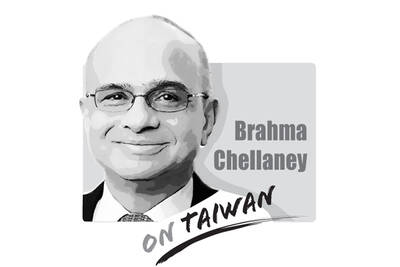As the Russia-Ukraine war continues, barely a day goes by without a report of a bridge being blown to smithereens by one side or the other. The tactical destruction of bridges is as old as war itself, with structures dismantled or dynamited to slow the progress of advancing forces, cut off supply lines or pin down a retreating army.
Amid the destruction, new bridges are also built during conflict to rapidly ferry troops and materials across rivers. During peacetime, bridges are economic corridors, linking population centers separated by nature. Bridges can also be used to advance diplomatic goals, such as the Sino-Nepal Friendship Bridge.
Given the strategic importance of bridges, it is bizarre that Taipei Mayor Ko Wen-je (柯文哲) should display such scant regard for national security by proposing the construction of a link between Kinmen County and China’s Xiamen.
Ko, who is also chairman of the Taiwan People’s Party, made the proposal at the opening ceremony of the party’s office in Kinmen on Saturday.
After he was challenged over the national security implications of a permanent land link with an enemy state, Ko said: “Try it first and deal with the problems if they arise.”
Ko’s blase riposte almost eclipsed the idiocy of the proposal. Did Ko have a similarly cavalier “try it and see” attitude toward his patients during his former career as a surgeon at National Taiwan University Hospital?
However, Ko is no dunce. As he is fond of saying, he has an IQ of 157. So what is he up to? There are several possible explanations:
Ko might have dreamed up a deliberately provocative policy to steal headlines and garner much-needed attention for his political party, buying into the idea that “there is no such thing as bad publicity.”
He might also have been following a “dead cat strategy,” making a deliberately shocking announcement to divert media attention away from a scandal over an alleged cyberdisinformation unit operating inside the Taipei City Government.
Or the bridge proposal might have been in response to the high-profile visit to the US by Chinese Nationalist Party (KMT) Chairman Eric Chu (朱立倫), during which Chu attempted to distance his party from Beijing and woo Washington. Ko might be playing political games, throwing out a pro-China “initiative” as red meat to poach disillusioned pro-China KMT voters.
He has a history of adopting contradictory positions designed to love bomb both sides of Taiwan’s political divide — a cynical “triangulation” strategy that seeks to appeal to pan-blue and pan-green voters.
There are two types of politicians: Those who want to do something, and those who want to be someone. Ko appears to fall into the latter category. He is fixated on becoming president to satisfy his own vainglorious pretensions. Lacking any firm political convictions, in the top office he would be as pliable as plasticine, and before long, well and truly under Beijing’s thumb.
Another possibility is that Ko actually favors unification and really does believe that Taiwan and China are “one family” — which he controversially said during a speech at a Taipei-Shanghai forum in 2015.
If this is the case, Ko should run on a joint ticket with former KMT chairwoman Hung Hsiu-chu (洪秀柱) and see how far that gets him.
Ko’s madcap bridge policy looks like nothing more than a cheap political stunt. It might go down well with a subset of pro-China voters in Kinmen, but it will sink like a lead balloon with the wider electorate.
The government and local industries breathed a sigh of relief after Shin Kong Life Insurance Co last week said it would relinquish surface rights for two plots in Taipei’s Beitou District (北投) to Nvidia Corp. The US chip-design giant’s plan to expand its local presence will be crucial for Taiwan to safeguard its core role in the global artificial intelligence (AI) ecosystem and to advance the nation’s AI development. The land in dispute is owned by the Taipei City Government, which in 2021 sold the rights to develop and use the two plots of land, codenamed T17 and T18, to the
US President Donald Trump has announced his eagerness to meet North Korean leader Kim Jong-un while in South Korea for the APEC summit. That implies a possible revival of US-North Korea talks, frozen since 2019. While some would dismiss such a move as appeasement, renewed US engagement with North Korea could benefit Taiwan’s security interests. The long-standing stalemate between Washington and Pyongyang has allowed Beijing to entrench its dominance in the region, creating a myth that only China can “manage” Kim’s rogue nation. That dynamic has allowed Beijing to present itself as an indispensable power broker: extracting concessions from Washington, Seoul
Taiwan’s labor force participation rate among people aged 65 or older was only 9.9 percent for 2023 — far lower than in other advanced countries, Ministry of Labor data showed. The rate is 38.3 percent in South Korea, 25.7 percent in Japan and 31.5 percent in Singapore. On the surface, it might look good that more older adults in Taiwan can retire, but in reality, it reflects policies that make it difficult for elderly people to participate in the labor market. Most workplaces lack age-friendly environments, and few offer retraining programs or flexible job arrangements for employees older than 55. As

Donald Trump’s return to the White House has offered Taiwan a paradoxical mix of reassurance and risk. Trump’s visceral hostility toward China could reinforce deterrence in the Taiwan Strait. Yet his disdain for alliances and penchant for transactional bargaining threaten to erode what Taiwan needs most: a reliable US commitment. Taiwan’s security depends less on US power than on US reliability, but Trump is undermining the latter. Deterrence without credibility is a hollow shield. Trump’s China policy in his second term has oscillated wildly between confrontation and conciliation. One day, he threatens Beijing with “massive” tariffs and calls China America’s “greatest geopolitical